-
Paper Information
- Paper Submission
-
Journal Information
- About This Journal
- Editorial Board
- Current Issue
- Archive
- Author Guidelines
- Contact Us
Resources and Environment
p-ISSN: 2163-2618 e-ISSN: 2163-2634
2016; 6(5): 89-94
doi:10.5923/j.re.20160605.01

Water Security Status in Saudi Arabia: A Threat for Food Security (2000-2014)
Hanady Rady1, Nagat Elmulthum2, Sara Elnasikh3
1Department of Agribusiness, and Consumer Sciences, Faculty of Agriculture and Food Sciences, King Faisal University, Saudi Arabia
2Department of Agribusiness, and Consumer Sciences, Faculty of Agriculture and Food Sciences, King Faisal University, Department of Agricultural Economics, Faculty of Agricultural Sciences, University of Gezira, Sudan
3Economic and Social Research Bureau, Sudan
Correspondence to: Nagat Elmulthum, Department of Agribusiness, and Consumer Sciences, Faculty of Agriculture and Food Sciences, King Faisal University, Department of Agricultural Economics, Faculty of Agricultural Sciences, University of Gezira, Sudan.
| Email: |  |
Copyright © 2016 Scientific & Academic Publishing. All Rights Reserved.
This work is licensed under the Creative Commons Attribution International License (CC BY).
http://creativecommons.org/licenses/by/4.0/

Provoked by the threatening situation of water scarcity, this paper aimed at analyzing the current situation of supply and demand for water in Saudi Arabia. The analysis depends on data from, Statistics of Ministry of Economics and Planning, Ministry Water and Electricity in Saudi Arabia, various issues of Statistical Year Book of the Central Department of Statistics and Information and FAO statistics. The authors employed descriptive statistics for analyzing the supply and demand for water in Saudi Arabia during the period 2000-2014. Water scarcity index was estimated for the study period. Regression analysis was employed for estimating the supply and demand functions for water during the period 2000-2014. Results obtained indicated that the increase in total supply of water may be attributed to the increase of, desalinated water, treated sewage water, and treated agricultural drainage water. Based on results, the highest water consuming sector is the agricultural sector as compared to municipal and industry sectors. Results indicated that demand for water is positively affected by the harvested area, population size and number of industries; however a negative relationship between demand for water and per capita gross domestic product is detected. Regarding supply of water, results obtained indicated that the supply of water is positively influenced by the production of desalinated water and the storage capacity of dams. However, a negative relationship between supply of water and the cost of production of desalinated water is observed. Results on per capita supply and demand for water, proved the threatening current and future situations of water security and food security in Saudi Arabia. This results, is confirmed further by high values of water scarcity index. Results on total harvested area and wheat production indicated negative trends during the study period, attributable to the risks associated with water scarcity.
Keywords: Food Security, Water Security, Water Scarcity Index, Desalination
Cite this paper: Hanady Rady, Nagat Elmulthum, Sara Elnasikh, Water Security Status in Saudi Arabia: A Threat for Food Security (2000-2014), Resources and Environment, Vol. 6 No. 5, 2016, pp. 89-94. doi: 10.5923/j.re.20160605.01.
Article Outline
1. Introduction
- Water security is one of strategic vital issues that attract the attention of researcher especially in the Arab region which is threatened by severe water scarcity in some of its countries. The situation is further complicated by population pressure and increasing demand for water by different sectors. The importance of the topic stems from the fact that water is the vital element in many aspects related to food security specially availability of food, which is the first pillar of food security. Bakker argued that water security is a convenient adequate level of water-related uncertainties to human beings and ecosystems, coupled with the obtainable adequate amount with reasonable quality to backup livelihoods, national security, human beings health and ecosystem services, as in [1].Based on the results obtained by Elmulthum, [2], availability of water on per capita basis in the Arab World, lessens from 3430 m3 in 1960 to 1250m3 in 2000 to 876 m3 in 2010. A further reduction in available water on per capita basis to 667m3 in 2025 and 500m3 in 2050 is anticipated. In addition, results obtained by Elmulthum, [2] indicated that food consumption gap in the Arab world raised from $1.1 billion in1973 to $27 billion in 2010. This situation could be explained by a number of factors including population growth, lower levels of real income, and the effect of climate change, which negatively influenced availability of water and agricultural production. This situation indicated a threatening situation for food and water security in the Arab World during the current century putting in mind that the water poverty line was estimated at 1000m3.“Arab countries face a serious food security challenge and that poverty rates are much higher than official numbers suggest. It blames the situation on vulnerability to volatile food prices, natural disasters and water scarcity” as in IFPRI. [3]. The concept of water security was reviewed by Cook and Bakkle from both academic and policy prospective. [4]. The authors compare the approaches followed by researchers in analyzing water scarcity and the definitions applied in natural and social sciences. The authors considered the preferences and prejudices of narrow versus broad and integrative framings of water security. They recognized their usefulness with reference to consolidated water wealth handling. Based on their results, they argued that an integrative approach to water security provide good governance the highest priority, thus provide a new promising tactic to water management.According to Bakker and Morinville [5], in addition, to week administrative resolutions, low optimum governance procedures, deficiency in science, rising environmental stress, increasing water insecurity arises from power relations, and rivalry between political and socioeconomic benefits related to land and water ownership and control. Hence, special attention should be given to the political and institutional aspects of water governance as well as issues of social power represents a paramount field of focus for water security potentials.According to the argument used by Fereres et al [6], given the rivalry for water confronted by the agricultural sector, and the risks characterizing climate change, upgrading the efficiency of water use in both rain-fed and irrigated sectors is the major path to confront the challenge of foreseeable rise in demand for food for the coming decades. Aiming at identifying social, economic, and engineering aspects affecting the domestic demand and consumption pattern of domestic water, in Riyadh, Saudi Arabia, Elzahrani et al [7] collected data on a number of variables related to domestic water consumption from a sample of households in Riyadh city applying social survey method. Based on Elzahrani et al [7], results positive and neutral trends towards rational use of water resources increase the prospects of improving trends in water consumption patterns. In addition, [7] emphasized the importance of media in increasing awareness in relation to the rational use of water. Moreover, a comparatively low water bill in relation to actual cost coupled with weakness of government oversight negatively affect water consumption patterns.According to Elzahrani and Moneer [8], argument, although Saudi Arabia managed to achieve food security during the last three decades it faces a number of challenges that threatens sustainability of these achievements. These challenges include among others scarcity of natural resources, especially water, increases in population growth rates, urbanization, and increases in household per capita consumption of water.Public consciousness of water deficiency problem in Saudi Arabia was measured by Ouda [9], using questionnaires in Al Khobar city in Eastern province of Kingdom of Saudi Arabia. Results from the survey showed low scales of water shortage consciousness among respondents. Based on Ouda [9], argument comprehensive work is stringently required to raise water consciousness through water media campaigns. Moreover, the author proposed the revision of the existing water pricing system and application of the pricing system as an economic incentives instrument for water conservation. Based on FAO [10], water resource administration in Saudi Arabia is characterized by heavily dependence on desalination. In addition, being a high income country it offers water almost for free. Moreover, in spite of huge operations and investments in water, considerable unfairness still remains coupled with weighty weaknesses in institutional capacity and governance. Furthermore, the water sector is seen as embodying great prospect for development and growth, it is expected that more than US$200 billion will be invested over the next 20 years on water and power projects, especially in water treatment plants, sewage plants, and desalination projects. The government is also moving forward in improving the water sector’s regulatory framework, and smoothing the way for privatization, especially in power and water desalination projects.
2. Methodology
- This section describes the methodology employed for the purpose of fulfilling the objective of this paper. Data on supply and demand of water was obtained from, Statistics of Ministry of Economics and Planning [11], and Ministry of Water and Electricity [12], in Saudi Arabia, various issues of Statistical Year Book of the Central Department of Statistics and Information [13], and FAO statistics [14]. Data on harvested area was obtained from Ministry of Agriculture in Saudi Arabia [15]. The authors employed descriptive statistics for the estimation of supply and demand for water. Assuming that water demand is affected by harvested area, population size, number of industries, and per capita gross domestic product, we used the following specification:
 | (1) |
 | (2) |
 | (3) |
3. Results and Discussion
- Figure (1) depicts water supply in Saudi Arabia from conventional sources during the period 2000-2014 which include surface and renewable groundwater and non renewable groundwater. It is clear from figure (1) that the water supply from conventional sources decreased from 20740 million m3 in 2000 to 13620 million m3 in 2014 with an annual reduction rate of 2.3%. However, regarding water supply from non conventional sources results indicated a steady increase by an annual rate by an annual rate of 10.3% during the period 2000-2014. It is clear from figure (2) that the supply of water from desalination industry increased from 971 million m3 in 2000 to 2070 million m3 in 2014. Desalination water plants had the highest contribution to water supply from non conventional sources averaging around 76% during the study period followed by Sewage and Agricultural drainage water contributing around 21% and 3%, respectively. Hence, faced by increasing role of desalination water as water source sustaining ground water in meeting increasing demand for water in Saudi Arabia, the big challenge is to raise the economic efficiency of the desalination industry, figure (2).
 | Figure 1. Water supply from conventional sources in Saudi Arabia in millions  (2000-2014). Source: Authors’ presentation based on data from [11] and [12] (2000-2014). Source: Authors’ presentation based on data from [11] and [12] |
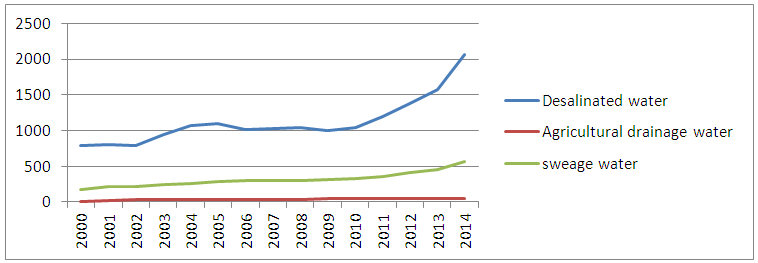 | Figure 2. Water Supply from non conventional sources. Source: Authors’ presentation based on data from [11] and [12] |
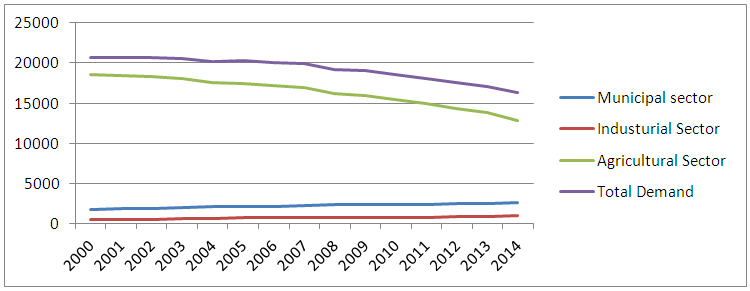 | Figure 3. Demand for water in Saudi Arabia by sector in millions  Source: Authors’ presentation based on data from [11] and [12] Source: Authors’ presentation based on data from [11] and [12] |
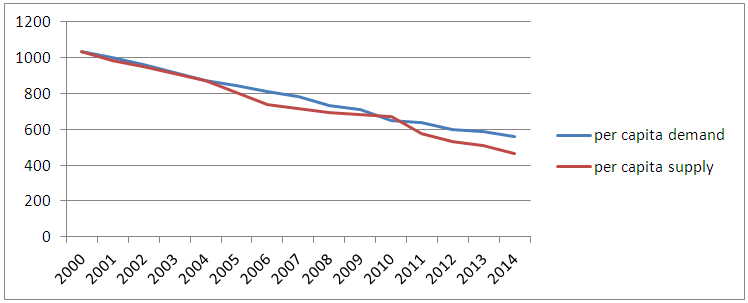 | Figure 4. Per capita supply and demand for water in Saudi Arabia in  . Source: Authors’ presentation based on data from [11], [12], and [13] . Source: Authors’ presentation based on data from [11], [12], and [13] |
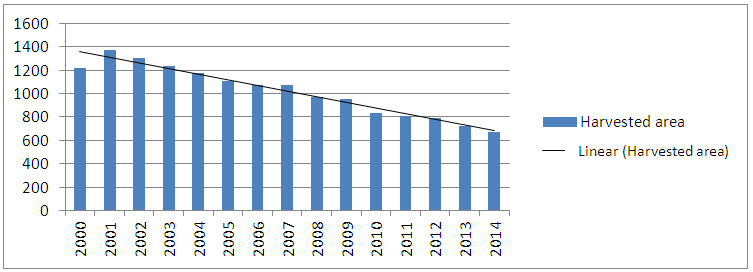 | Figure 5. Harveated area in million Ha. in Saudi Arabia (2000-2014). Source: author’s presentation based on data from [15] |
 | Figure 6. Wheat production in (000) tons in Saudi Arabia (2000-2013). Source: Authors’ presentation based on data from [14] |
 | (4) |
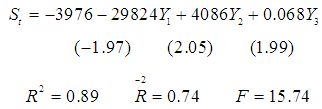 | (5) |
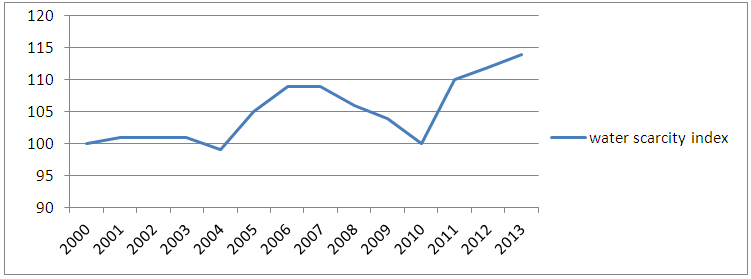 | Figure 7. Water scarcity index (%) in Saudi Arabia (2000-20014). Source: Authors’ calculations based on data from [11] and [12] |
4. Conclusions and Policy Recommendations
- Water and hence food security situation in Saudi Arabia is at risk. The country is highly dependent on non conventional water sources, with particular emphasis on desalinated water. The agricultural sector is the highest water consuming sector making the policy option of self sufficiency in food in Saudi Arabia a risky option. Based on the research results limiting the expansion of crops of high water requirements is highly recommended. In addition, investment in agriculture is recommended in countries rich in water resources with particular emphasis on comparative advantage of food crops in selected countries. Further studies, on water requirements of food crops in different regions in Saudi Arabia are highly recommended.
 Abstract
Abstract Reference
Reference Full-Text PDF
Full-Text PDF Full-text HTML
Full-text HTML